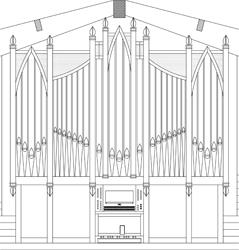
M. P. Rathke, Inc., of Spiceland, Indiana, has completed a new organ for St. John Lutheran Church, Wheaton, Illinois.
A two-manual and pedal instrument of 34 stops and 46 ranks, Opus 5 is housed in a freestanding case of red oak with pipe shades and keydesk of black walnut. The Great hammered lead chorus is founded on a 16′ Prestant which appears in the façade down to low GG#, with the bottom 8 notes standing inside the case at balcony floor level. The Swell features an assortment of vintage Romantic pipework retained from a 1911 Weickhardt organ originally installed in Bethel Lutheran Church, Chicago. The Pedal is based on a 16′ Open Wood and augmented by a full-length 16′ Trombone with poplar resonators of large scale.
Stephen Tharp will present the dedicatory recital on September 21, 7 p.m.
For information: http://www.rathkepipeorgans.com.



